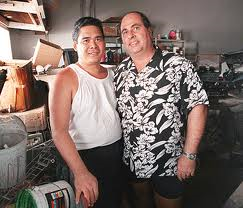As the Supreme Court hears oral arguments to legalize same-sex marriage in the United States, it is important to acknowledge the spark that started the marriage equality firestorm. Conventional wisdom says, “Success has many fathers, failure is an orphan.” That is why it is critical that we look back at how the same-sex marriage debate got started in the United States.

In 1990, three same-sex couples decided to do something that was considered revolutionary. Joseph Melillo and Pat Lagon, Tammy Rodrigues and Antoinette Pregil and Ninia Baehr and Genora Dancel, applied for marriage licenses in Hawaii. The idea to apply for marriage licenses was created by local activist Bill Woods’ desire to have a local commitment ceremony for gay pride. Ultimately, the concept led to the three couples applying for marriage licenses Dec. 17, 1990. The couples’ applications were denied. They sued.
The Baehr case made it to the Hawaii Supreme Court in 1993. The court issued a complex opinion; it ruled that same-sex marriage was not a fundamental right in the Hawaii state Constitution but denying same-sex couples the right to get married defied the equal rights protections granted by the state’s constitution. The gauntlet was thrown and the marriage equality games began.
The Supreme Court returned the case to the lower trial court and instructed the trial court to prove that there was some compelling state interest to deny same-sex couples the right to marry. In 1996, the trial court ruled that the state had not proven its case which allowed same-sex couples to marry. The elation of the LGBT community was short lived, the next day the court “stayed” the ruling, meaning same-sex couples could not marry until the case was completely adjudicated in the Hawaii Supreme Court yet again.
Dan Foley was the attorney who argued the case for same-sex marriage – a straight man who had worked for the American Civil Liberties Union.

Marriage equality opponents mounted a campaign to put a Hawaii constitutional amendment on the ballot that would deny same-sex marriage in the state. Many LGBT equality organizations and activists felt that the Hawaii Supreme Court would rule before the constitutional amendment would be put before the voter. They were wrong.
In 1997, the Hawaii state legislature proposed a constitutional amendment to allow the state government to deny same-sex couples marriage equality. The amendment appeared on the ballot in 1998 while the Baehr case was still before the Hawaii Supreme Court. The LGBT community was caught flat-footed. The debate about whether these couples should have pursued marriage at all was still waging within the LGBT community, let alone the thought that there was going to be substantial dollars needed to fight the constitutional amendment. The Hawaii Equal Rights Marriage Project (HERMP) run by Sue Reardon was the local organization mounting the fight against the constitutional amendment. HERMP was underfunded and did not have the capacity or experience to raise the funds to fight the anti-same-sex marriage foes.
The Human Rights Campaign was the only organization with the structure or financial support that could raise the money needed to fight the constitutional amendment with the voter at the ballot box. HRC set a fundraising goal of $1 million to be spent educating the voter about same-sex marriage and how it fit within the open culture of Hawaii. HRC Executive Director Elizabeth Birch was a former Hawaii resident and was committed to the cause because of its far reaching implications.
The anti-marriage equality amendment passed overwhelmingly; 69.2 percent supported the amendment, 29.6 percent opposed. The new language in the Hawaii Constitution was simple and straight forward, “The legislature shall have the power to reserve marriage to opposite-sex couples.” The Hawaii amendment paved the way for scores of other state anti-marriage equality amendments to come.
In 1999 on the heels of the new constitutional amendment, the Hawaii Supreme Court ruled that the addition to the state constitution prevented the couples from suing the state for the right to get married. For the time being, same-sex marriage in Hawaii and beyond was dead.
A simple act by three couples and a savvy lawyer put the concept of same-sex marriage on the worldwide agenda. In 1990 when these same-sex couples applied for marriage licenses not one country in the world allowed unrestricted same-sex marriage. Five countries allowed same-sex couples to “marry” with varying restrictions around adoption, church weddings and artificial insemination; Denmark, Norway, Sweden, Iceland and Hungary. Our Hawaii heroes wanted full marriage rights, a bold demand anywhere, let alone the United States.
So as we all wait for the Supreme Court ruling anticipated in June, we should not forget those who stepped forward to make Hawaii the failure that led to success; same-sex marriage in many countries throughout the world. The question is if our Hawaii heroes will get their ultimate prize; full marriage equality in the United States.
STAMPP CORBIN
PUBLISHER
San Diego LGBT Weekly
LGBTweekly.com












One problem with the effort to defeat the constitutional amendment in 1998 – the organization(s) involved felt keeping the GLBT communities out of the public eye, making the fight about something else was the way to go – but was a losing proposition. We won later when the education was done that everyone has a relative, a doctor, a grocer, a local policeman or fireman, a nurse, a teacher, etc. – that was negatively impacted by the lack of marriage equality.